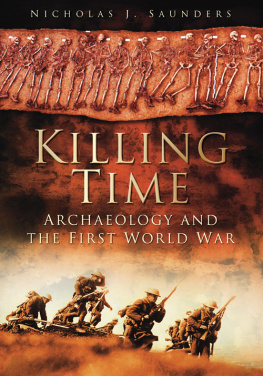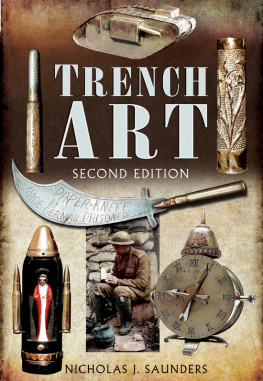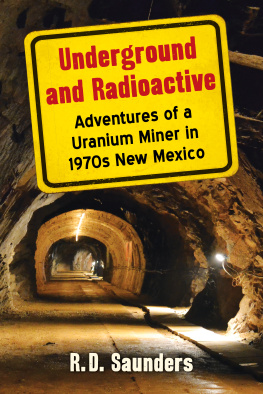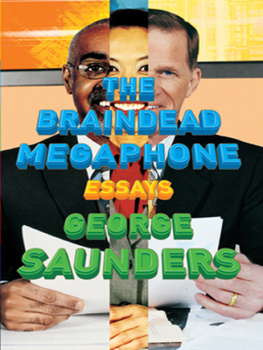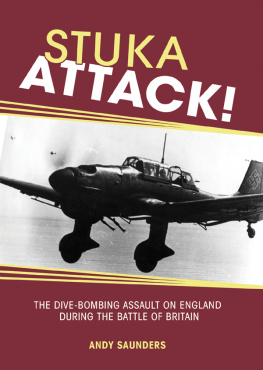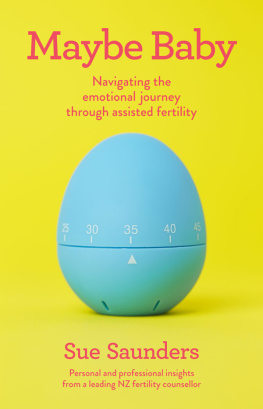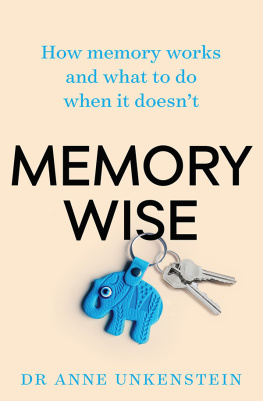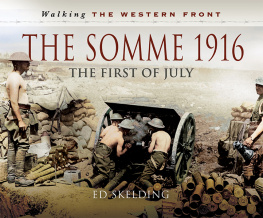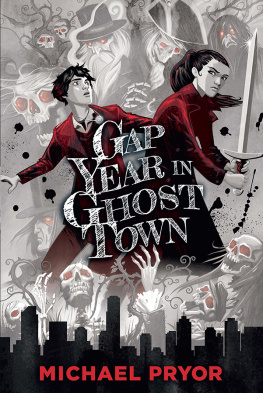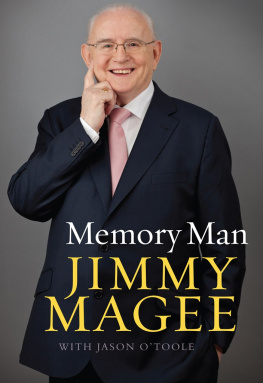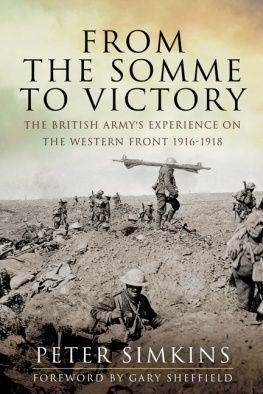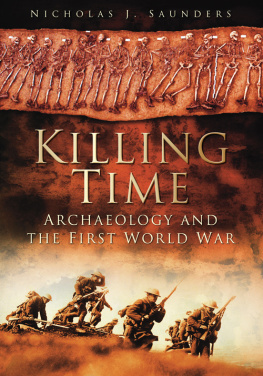
In memory of Bob Craig (19502006)
It is inevitable that a book such as this relies to an overwhelming extent on the professional work, advice, comments and goodwill of many colleagues from a wide range of disciplines, as well as on the support of family, and the companionship of personal friends. I owe a great debt to all the individuals listed below, whose cooperation, expertise, insights and friendship have greatly influenced my own work, and made this book possible. None of them is responsible for what I have made of their many generosities.
As it would be invidious as well as impossible to rank these individuals according to my gratitude, I list them here in alphabetical order: Frdric Adam, Zeyad al-Salameen, Stphane Audoin-Rouzeau, Marco Balbi, Annette Becker, Barbara Bender, Bob Bewley, Franky Bostyn, Jean Bourgeois, Isabelle Brandauer, James Brazier, Andy Brockman, Graham Brown, Martin Brown, David Cameron, John Carman, Piet Chielens, eljko Cimpric, Hugh Clout, David Cohen, Thomas Compre-Morel, Paul Cornish, Susan Daniels, Janiek Degryse, Anna Gow, Armando De Guio, Mark Dennis, Roger De Smul, Dominiek Dendooven, Aleks Deseyne, Yves Desfosss, Jan Dewilde, Marc Dewilde, Mike Dolamore, Nils Fabiansson, Hani Falahat, Neil Faulkner, David Field, Paola Filippucci, Philippe Gorczynski, Paul Gough, Fabio Gygi, Andy Hawkins, Italo Hellmann, Gary Hollingsworth, Patrik Indevuyst, Alain Jacques, David Kenyon, Arlene King, Joe Lahae, Mathieu de Meyer, Tom Morgan, Richard Osgood, Jon Price, Pedro Pype, Paul Reed, Rik Ryon, Jacques Schier, John Schofield, Aurel Sercu, Mansour Shqiarat, Ivan Sinnaeve, Tony Spagnoly, Harald Stadler, Birger Stichelbaut, David Thorpe, Christopher Tilley, Senior Captain A. Vander Mast, Johan Vandewalle, Gabriel Versavel, Carol Walker, Roger Ward, Patrice Warin, the late Marian Wenzel, John Winterburn, and John Woolsgrove, as well as www.greatwar.be and www.suffolkchurches.co.uk.
As always, I owe a great debt to my wife, Pauline, my children, Roxanne and Alexander, my parents, Geoff and Pat Saunders, and, ultimately, to my grandfathers, Alfred William Saunders of the Kings Own Royal Regiment (Lancaster) and Matthew Inkerman Chorley of the South Lancashire Regiment. Both fought in the First World War and survived. I can only imagine what they would have thought about the idea that the war that forged them as young men would, almost within their own lifetimes, become a part of archaeology.
Contents
The First World War remains ambiguously recent in the European imagination hovering above the border where oral history, military history and cultural history meet individual and collective memories. Its objects live on in peoples homes, in museums and in salesrooms, and its legacies permeate the tortuous politics of identity, via nationalism and ethnicity, across Europe and beyond. The war exists also in the conjoined worlds of tourism and heritage, with ever-increasing numbers of visitors to its battlefields and museums, especially along the old Western Front of Belgium and France the focus of this book.
Yet, until recently, almost nothing that we knew of the First World War (the Great War) had come from beneath the soil, from innumerable kilometres of now subterranean trenches, dugouts, hospitals, bomb craters, tunnels and impromptu battlefield graves. It is as if the idea of an archaeology of the war was somehow beyond reach, or perhaps not worth bothering about, as everything we needed to know could be gleaned from the historical accounts of its many battles, and their tragic cost in human lives and suffering. Was the First World War suitable for archaeological excavation? Was it not too recent? Could archaeology tell us anything new?
Times change, and ideas and attitudes change with them. The past ten years have seen extraordinary developments in what can now be called, without fear of contradiction, the archaeology of the First World War. A decade ago it seemed to me, and to others, that here was a vast new field of archaeological (and anthropological) research that had hardly been considered, far less acted upon. I remember tramping the battlefields of the Western Front in all weathers, searching for examples of curious objects called trench art three-dimensional items made by soldiers and civilians (often as souvenirs) during and after the war and encountering landscapes and material culture that had only ever been in the background of the great military histories of the war.
I heard dark rumours of clandestine battlefield digging, of soldiers bodies torn from the earth and stripped of their equipment and personal possessions, and of almost mythical private collections of the trench art I sought, and of other objects from the war. I wandered through museums, large and small, in which there was a wealth of objects waiting to be studied, and across old battlefield landscapes whose archaeology had only fleetingly been touched, and whose anthropological dimension had hardly even been considered. And, in countless interviews, I came across ideas, stories, insights and attitudes that seemed to move effortlessly back and forth between the trench art I had come to study, family experiences and memories of the war, and the surface worlds and underground landscapes of the conflict. Running through all these varied aspects like an electric current were the lives of real people. They had names, signatures and faces, and their letters, photographs and objects seemed to me to announce a new kind of archaeology that of the recent historical past in time of conflict.
Great War archaeology is a complex endeavour. In one sense, it is a kind of industrial archaeology, whose strata are saturated with mass-produced artefacts of the twentieth century an overwhelming sea of materiality that seems to mock the archaeologists quest for meaningful patternings of objects. In another sense, it is historical archaeology, informed by a wealth of written documents on every conceivable aspect of the conflict, from trench life to global military strategy, from the personal meanings of memorabilia to the international consequences of its aftermath. It is also social archaeology, public archaeology, and anthropological archaeology, and one of the many so-called archaeologies of the contemporary past.
Great War archaeology is all of these and more, for it deals with the actions and consequences of modern industrialised war on a global scale. It is the archaeology of new worlds brought into being at terrible cost between 1914 and 1918 worlds that have transformed themselves ever since, within which we still live today, and with whose legacies we still struggle, whether in Bosnia, Gaza or Iraq.
This book focuses mainly on the old battlefields of the Western Front, for it is here that most archaeology and anthropology has been carried out, and it is here also that the issues of heritage and tourism are currently most accessible. It is here, too, that younger generations are being motivated as much by what lies beneath the battlefields, and what this tells us of the human experience of war, as previous generations were (and still are) by the more traditional historical accounts of the First World Wars many iconic battles. Great War archaeology is, ultimately, the archaeology of us, and it is only just beginning.
CHAPTER 1
The passage of time has all but extinguished any living memory of the Great War of 1914-1918, but the experiences of those who fought in the trenches of the Somme in northern France, and around the town of Ypres in Belgian Flanders, have since become epic history and the stuff of legend.
Today, hardly a month passes without some dramatic and often poignant discovery along the old killing fields of the Western Front in France and Belgium. Evocative burials of British, French or German soldiers buried during battle and then forgotten lying in rows seemingly arm in arm, interred in a makeshift shell-crater grave, or found still crouching after eighty-five years at the entrance to a dugout. Whole underground cities of trenches, dugouts, galleries and shelters lie preserved beneath the mud of Flanders sometimes with newspapers, blankets and socks scattered where they were left. Underground field hospitals carved into the chalk country of Artois and Picardy in France also survive, as do hundreds of kilometres of tunnels scratched with graffiti by long-dead hands. Most threatening of all, countless tons of volatile bombs and gas canisters still wait for a chance to explode. Almost a century after the war ended, on 11 November 1918, there is an annual loss of life caused by this deadly legacy of the war to end all wars.
Next page
